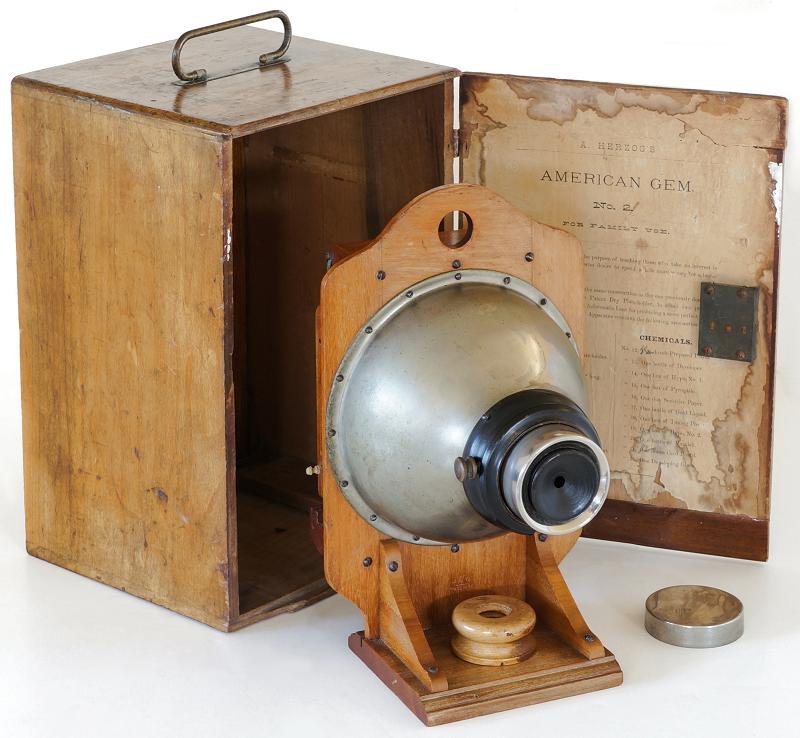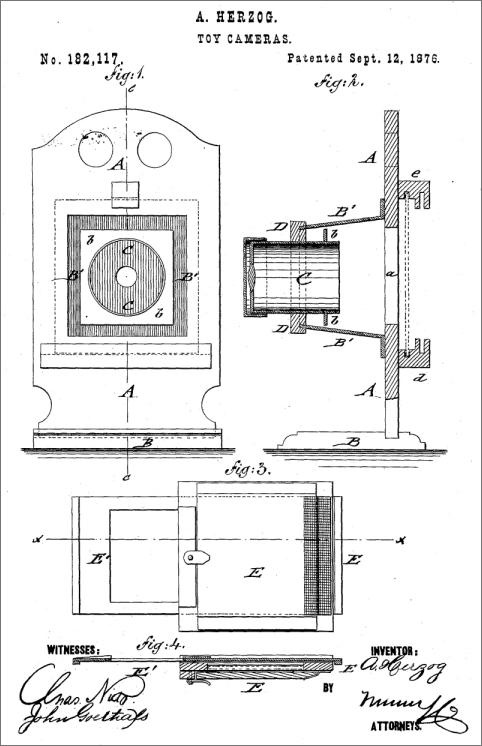|
|


Although we don't know what the earliest dedicated 'teaching' or 'toy' cameras
are, or when they were introduced, the 1876 and 1881 Herzog cameras are
certainly among the first, if not the first. In 1876, August Herzog was granted U.S.
patent No. 182,117 (Sept. 12, 1876 - reissued Sept. 20, 1881 as No. 9,878) for an
Improvement in Toy Cameras with an intent to make it easy to inexpensively learn
photography. According to the patent:
..........."My invention relates to an improved toy photographic apparatus,
...........of simple and cheap construction, designed for the instruction and
...........amusement of children and grown people."
One month after the patent was granted; the October 21, 1876 issue of Scientific American included a brief announcement of Herzog's "Toy Camera" in its New Miscellaneous Inventions column (page 267):
..........."August Herzog, New York city.-This is a photographic apparatus,
...........of simple construction, consisting of an upright frame, to which a
...........camera, with sliding lens tube, is applied. Supports are also provided
...........for a ground glass and plate holder."
Herzog's first camera - the Popular Photograph Camera - was conceived at a time of simpler pleasures and must have been quite surprising to a public accustomed to playing with wooden building blocks, tin vehicles, dolls and carriages, kites and the like - toys that encouraged active participation and imagination. The late 1870s was also a time of great transition and business expansion. The first telephone call was made in 1876 and barely two years later, in 1878, the first commercial telephone exchange opened in New Haven Connecticut. A year later, on 22 February 1879, Frank W. Woolworth opened his first 5 cent & 10 cent store in Utica, New York. And most importantly, simpler dry-plate technology was replacing an arduous wet collodion process. Given these events, it would seem that the 1870s was a fitting time for a toy camera - an entertainment and learning tool - that could foster a new generation of photographers eager to embrace easy to make inexpensive pictures.
Herzog's camera was small and used odd sized 2" x 2½" plates. As with other toys of the time, it was fundamentally simple. Yet compared to other apparatus, the Popular Photograph Camera was vaguely photographic in appearance: Think of a partially completed project which at some point a recognizable camera emerges. This first model is quite rare with only two examples known. In A Century of Cameras (page 22), Eaton Lothrop writes that it also sold under the name Centennial Photographic Apparatus, by E. Sackman & Co., Brooklyn, N.Y., which claimed it as "the most amusing and instructing toy ever invented."
..........."My invention relates to an improved toy photographic apparatus,
...........of simple and cheap construction, designed for the instruction and
...........amusement of children and grown people."
One month after the patent was granted; the October 21, 1876 issue of Scientific American included a brief announcement of Herzog's "Toy Camera" in its New Miscellaneous Inventions column (page 267):
..........."August Herzog, New York city.-This is a photographic apparatus,
...........of simple construction, consisting of an upright frame, to which a
...........camera, with sliding lens tube, is applied. Supports are also provided
...........for a ground glass and plate holder."
Herzog's first camera - the Popular Photograph Camera - was conceived at a time of simpler pleasures and must have been quite surprising to a public accustomed to playing with wooden building blocks, tin vehicles, dolls and carriages, kites and the like - toys that encouraged active participation and imagination. The late 1870s was also a time of great transition and business expansion. The first telephone call was made in 1876 and barely two years later, in 1878, the first commercial telephone exchange opened in New Haven Connecticut. A year later, on 22 February 1879, Frank W. Woolworth opened his first 5 cent & 10 cent store in Utica, New York. And most importantly, simpler dry-plate technology was replacing an arduous wet collodion process. Given these events, it would seem that the 1870s was a fitting time for a toy camera - an entertainment and learning tool - that could foster a new generation of photographers eager to embrace easy to make inexpensive pictures.
Herzog's camera was small and used odd sized 2" x 2½" plates. As with other toys of the time, it was fundamentally simple. Yet compared to other apparatus, the Popular Photograph Camera was vaguely photographic in appearance: Think of a partially completed project which at some point a recognizable camera emerges. This first model is quite rare with only two examples known. In A Century of Cameras (page 22), Eaton Lothrop writes that it also sold under the name Centennial Photographic Apparatus, by E. Sackman & Co., Brooklyn, N.Y., which claimed it as "the most amusing and instructing toy ever invented."
A. Herzog's American Gem No.2 toy camera for "Family Use"
Copyright ©2013 by Rob Niederman - ALL RIGHTS RESERVED
Return to the View Cameras page
Multi-Lens Cameras | View Cameras | Self-Casing Cameras | Solid Body Cameras | References & Advertisements
Home | What's New | Show Schedule | Wanted | For Sale | Links | Site Map | Email
Home | What's New | Show Schedule | Wanted | For Sale | Links | Site Map | Email
Designed for the instruction and amusement of children
and grown people When do new technologies get to a point
of being easily learned and adopted? Our lives are surrounded
by undemanding products that started, by today's standards,
as crude and difficult to comprehend and operate. This
includes photographic equipment and processes. At present,
we enjoy highly automated digital cameras, tablets and
smart-phones for effortless picture taking at the touch [or
click] of a button. These 'cameras' practically do all the work
and afterwards digital images can be shared instantly and
globally using any number of social-media applications. Oddly,
the learning curve has shifted from cameras to applications -
but what about really early apparatus?
Starting with the first commercial camera and process announcement of 1839, education has been an uphill battle. These days we still consider the daguerreotype process complex yet, in 1839 and subsequent years, beleaguered photographers had to be chemists as well as artists to make images. As photographic technology evolved over time, the learning curve became somewhat easier but not necessarily 'easy' even as dry-plates started replacing the wet collodion process throughout the 1870s. Propagation of the art of photography more or less resided with entrepreneurs and skilled studio assistants who were fortunate to have been mentored by a first generation of professionals and enthusiasts who invested years to master the craft.
Additionally, part of the satisfaction of being a professional photographer is the ability to control the technical process; which helps practitioners to more-or-less concentrate on the image. Over time, an increasing number of amateurs and beginners jumped in. Big makers watched and responded with their own amateur equipment outfits, and the so-called mysteries of photographic technique unraveled and passed quickly down to new generations of consumers.
In looking at the history of early photographic apparatus and their makers since its beginnings, there were numerous 'How to ...' publications and other ephemera that also took on the role of teaching photography. And by the 1880s, some of these instruction books included commentary about making money with cameras; which is a good benchmark of when technology becomes less challenging to learn and use.
Starting with the first commercial camera and process announcement of 1839, education has been an uphill battle. These days we still consider the daguerreotype process complex yet, in 1839 and subsequent years, beleaguered photographers had to be chemists as well as artists to make images. As photographic technology evolved over time, the learning curve became somewhat easier but not necessarily 'easy' even as dry-plates started replacing the wet collodion process throughout the 1870s. Propagation of the art of photography more or less resided with entrepreneurs and skilled studio assistants who were fortunate to have been mentored by a first generation of professionals and enthusiasts who invested years to master the craft.
Additionally, part of the satisfaction of being a professional photographer is the ability to control the technical process; which helps practitioners to more-or-less concentrate on the image. Over time, an increasing number of amateurs and beginners jumped in. Big makers watched and responded with their own amateur equipment outfits, and the so-called mysteries of photographic technique unraveled and passed quickly down to new generations of consumers.
In looking at the history of early photographic apparatus and their makers since its beginnings, there were numerous 'How to ...' publications and other ephemera that also took on the role of teaching photography. And by the 1880s, some of these instruction books included commentary about making money with cameras; which is a good benchmark of when technology becomes less challenging to learn and use.
American Gem No.2, 1881
August Herzog's Toy Cameras - page 1
August Herzog's Toy Cameras - page 1

